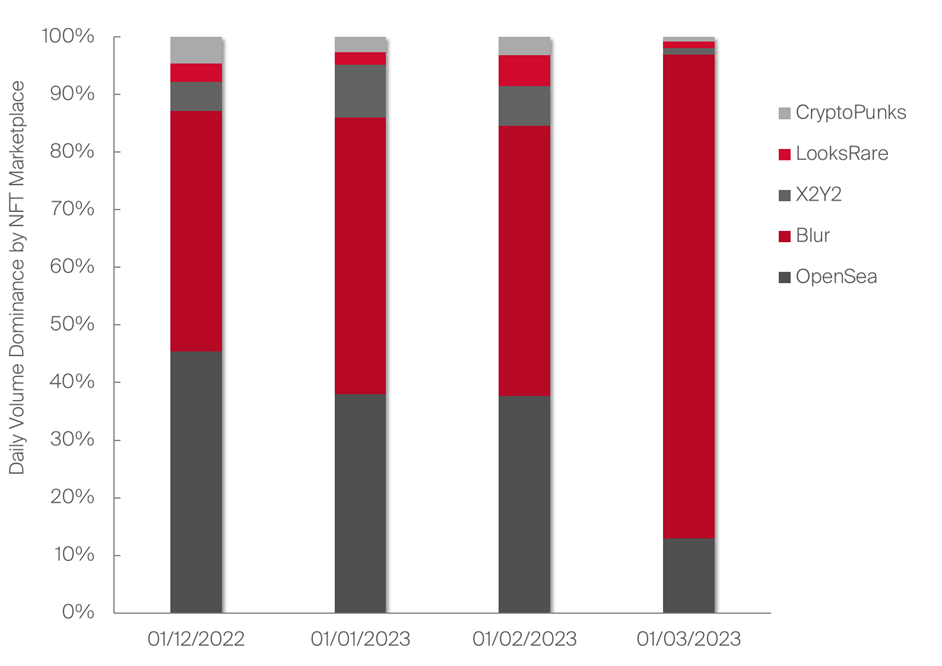
NFT marketplace Blur, Stablecoin Wars, Bridge Hacker “hacked back”

1. NFT marketplace OpenSea finally found a worthy rival
The Facts:
- NFT marketplace OpenSea has been dominating the NFT sector ever since, with competitors such as X2Y2, LooksRare or MagicEden not standing a chance in the past.
- Newcomer NFT marketplace Blur, starting in October 2022 as an aggregator, is the first serious competitor to now outpace OpenSea, exceeding it in daily trading volumes.
- Ironically, Blur is built on the SeaPort protocol, OpenSea’s permissionless protocol layer.
Our Take:
- Blur offered zero trading fee with optional royalty which is mostly attractive to price sensitive NFT traders that want to speculate on price moves, rather than hold their NFTs for the long-term.
- Though they were not amongst the first NFT marketplaces to offer low trading fees, they took the race to zero trading fees to the next stage, offering tremendously cheaper NFT trading.
- It is to be seen how the optional royalty Blur implemented will impact creators’ willingness and incentive structure, as a mandatory royalty implies that the initial creators receive a cut of the transaction price paid, every time their NFT gets traded.
- Overall, some newfound competition in the NFT space is healthy, with the rise of Blur forcing former market leader OpenSea to change its monetization mechanics.
- It appears that a narrative change is taking place, abandoning the past tradition of royalties being paid with every NFT trade.
- Nevertheless, it has to be considered that Blur’s current adoption is based at large on their incentive structure and potential airdrops, implying that a lot of volume is generated by people hoping to earn extra rewards.
- This is an effect that took place with various projects in the past, once the rewards run out, activity quickly shifts elsewhere.
- Implications going forward are increased liquidity and trading volume amongst NFTs, as has been confirmed by the recent rise in NFT activity.
2. Stablecoin Wars
The Facts:
- The stablecoin landscape is undergoing major developments, with the recent decline of Binance stablecoin (BUSD), with Coinbase halting all BUSD trading later this month.
- Recently, DeFi stablecoins have been rising and more protocols are issuing their own stablecoin, mainly due to the need for new revenue streams amidst drying up volumes in the current bear market.
- Recent newcomers for decentralized stablecoins are lending protocol Aave’s GHO, and DEX Curve’s crvUSD stablecoin.
Our Take:
- Binance’s attempt past year, of pushing BUSD dominance, by converting all major stablecoin balances on their exchange, such as USDT or USDC, into BUSD, effectively only trading vs BUSD stablecoins on their platform, seems to backlash in the current regulatory regime and headwinds it is facing from U.S. territory.
- The current headwinds and scrutiny surrounding centralized stablecoins, as well as drying up volumes of major DeFi protocols lead to the recent increase in decentralized alternatives.
- Further incentives for protocols to issue their stablecoin come not only from future revenue increases, but also the token holders of Aave and Curve probably will see an increase in yields, making formerly governance heavy tokens more attractive from a yield token perspective.
- An increase in the number of different stablecoins will lead to liquidity fragmentation, however, with too many smaller stablecoins, not enabling large volumes to be traded by single traders in a single currency.
- On the other hand, DeFi borrowing rates are relatively low, usually at 1-2%, implying that in the current inflation regime with interest rates being hiked for every major currency, borrowing stablecoins in DeFi should prove to be a less costly source of liquidity than CeFi loans.
- Overall, the trend to more decentralized alternatives for stablecoins, that cannot be affected from centralized entities and the regulatory regime of a given day, is a positive trend for the industry going forward.
3. Jump Crypto reclaims $140 million from Wormhole hacker
The Facts:
- Crypto trading firm Jump Crypto and Oasis “recovered” $140 million from the Wormhole hacker last week, by hacking the hacker back, who initially exploited roughly $322 million from the Wormhole bridge last year.
- Wormhole is a platform that supports the bridging and interaction between multiple blockchains such as Avalanche, Oasis, Ethereum, Polygon and others, offering attractive functionality, that comes with a downside of relatively easy exploitation and hacking, due to the increased risks and technical hurdles it takes to connect different blockchains.
- The funds have been re-exploited to abstract the funds from the hacker and return it to the protocol, by using “upgradeable” smart contracts, that are mutable and can be changed in hindsight.
Our Take:
- Having funds returned and reclaimed from a hacker does seem to be a good thing happening overall, but it raises concerns as to how the developers and founders behind a protocol are able to achieve this.
- Of course, stealing funds is bad, yet the only means by which a hacker can exploit, and gain “stolen funds” is by using open loopholes and flaws in smart-contracts, i.e. operating within the established limits of how a protocol was set up to operate.
- Even though funds are abstracted, in the long-term these “hacks” make smart-contracts more robust and help avoid implementing such flaws in the first place, going forward.
- The most critical part about the incident, of exploiting the hacker, is that developers built in a “back-door” which allowed them to use upgradeable smart contracts for their own benefit and effectively giving the hacker a taste of his own medicine.
- Problematic is, that in “decentralized” finance, the developers behind a protocol should not have the power and means, to perform such operations, and the question remains as to how much decentralization certain protocols actually have.
- Troublesome is the extended connection, that Oasis has with DeFi lending protocol Maker, with Oasis being one of the frontends for Maker, giving questionable implications for the leading lending protocol’s actual decentralization.
- Furthermore, Oasis has been ordered by the High Court of England and Wales to reclaim their assets, giving potentially dangerous implications for the future, if central authorities can pressure crucial engineers and developers to exploit their own protocols for certain outcomes.
In other news
- Coinbase to suspends BUSD trading in March (via Coinbase)
- Mt. Gox repayments starting after 9 years (via TheBlock)
- 4% tax incentive for crypto in Puerto Rico (via CoinDesk)
- SEC subpoenas Robinhood over crypto operations (via Decrypt)
- Potential clawback on Voyager customer funds (via Cryptoslate)
- Crypto industry distancing itself from Silvergate bank (via Cointelegraph)
- Coinbase CEO’s warning to U.S. policymakers and regulators (via Coinmarketcap)
Hmm … Not very decentralised if the protocol can unilaterally collude with an aggrieved party to snatch assets from another user. How is this any different than keeping your fiat in a bank? Not sure how Maker has any USP if this is true.
Arthur Hayes regarding the reclaiming of the Wormhole hacker’s assets by Oasis and Jump Crypto – via Twitter
$140 million
- The amount that Jump Crypto “reclaimed” i.e., hacked back from the Wormhole hacker that stole roughly $322 million in a bridge exploit last year
Plotting the daily volume dominance of the five major NFT marketplaces over the past three months

Curious what the year 2023 will look like? Read our 2023 Outlook, which has been published recently.